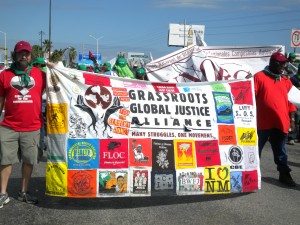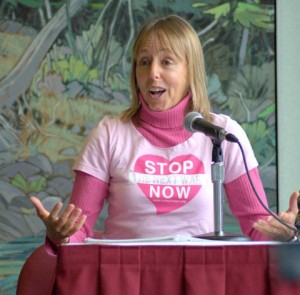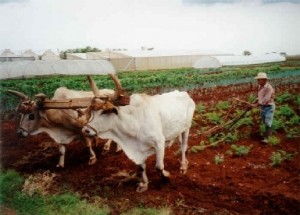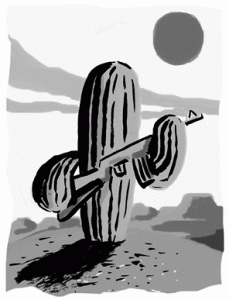This article was shared to us by allies at EcoViva. Journalist, Dahr Jamail recently returned from El Salvador and has been writing about the climate change work that EcoViva has been working on. For up-to-date information about EcoViva’s work, visit their blog. This article is cross-posted from Al-Jazeera.
By Dahr Jamail
While debate about whether climate change is real or not continues in the US, the world’s leading producer of CO2 emissions per capita, those already living with the effects, like Jose Domingo Cruz in El Salvador, don’t have time to debate.
“Our storms are increasing in number and intensity,” Cruz, a member of his community Civil Protection Committee that responds to community needs during natural disasters, told Al Jazeera while standing on a levy that ruptured during Tropical Storm Agatha last year. “All of us attribute this to climate change.”
The levy, originally constructed in the aftermath of devastating floods caused by Hurricane Mitch in 1998, now has two huge ruptures in need of repair before the next hurricane season that begins in roughly six months.
A severe drought in 2008 and 2009, and Hurricane Stan in 2005, also took a severe toll on both land and lives in the area. Increasing sea levels will also heavily impact this part of El Salvador, which is largely populated by people who had to flee the US-backed war that raged in the country from 1979 to 1992.
A 2007 climate change study conducted by El Salvador’s National Ministry of the Environment and Natural Resources focused on the Lower Lempa River and Bay of Jiquilisco areas of the central Pacific coast.
The study found that this area can expect more of what it is already experiencing: increasing minimum and maximum temperatures, a shift in observed seasons, more frequent observations of extremely wet and extremely dry years, and intensified extreme event activity, including tropical storms and hurricanes.
Against the backdrop of these dire predictions, the people are, however, forming a movement that is learning to protect and sustain itself in the increasingly chaotic world of global climate change and its severe ramifications on people, the environment, and local economies.
Social movement as survival mechanism
In addition to climate change, El Salvador faces environmental issues that include deforestation, soil erosion, water pollution, and soil contaminated from decades of cotton and sugar cane production using toxic herbicides and fertilisers.
El Salvador is the 2nd most deforested country in the Western Hemisphere, second only to Haiti. Only two per cent of primary forest that existed 50 years ago remains today.
In response to increasing natural disasters related to climate change – and as an effort to promote environmental protections and sustainable living – a group known as The Mangrove Association was birthed in 1999. Members of the group are primarily subsistence farmers and fisher-folk whose livelihoods depend on the viability of local ecosystems now threatened by climate change and unsustainable farming practises like those practised by the sugar cane industry.
Estela Hernandez, member of the board of directors of the Mangrove Association, a group that assists local communities in sustainable living practises and in adapting to climate change.
“The sugar-cane industry here now has expanding borders,” Estela Hernandez, member of the board of directors of the Mangrove Association, told Al Jazeera. “They are taking more water, and the chemicals they use are making people in nearby communities sick.”
Hernandez’s group works to support a grassroots coalition of community groups called La Coordinadora, that today includes more than 100 communities. With assistance from EcoViva, a group that enables grassroots leadership in the area by assisting with financial and technical resources, the Mangrove Association functions as a grassroots response to address the crisis causing effects of climate change in this region of El Salvador.
“Local communities are on the front-lines of climate change, and many local organisations like the Mangrove Association are offering the only significant response to this very serious problem,” Nathan Weller of EcoViva told Al Jazeera. “Communities like those in the Bay of Jiquilisco can no longer rely solely on the conventional development model to intervene for them. They live the effects of climate change, are working actively on solutions to confront them, and the Mangrove Association serves to catalyse these efforts.”
In what has become a major grassroots social movement that aims to increase diversified sustainable farming, organic foods, food security, and all of this via environmentally friendly methods, many people living in this area are actually seeing their lives improve, despite the challenges.
Yet, the challenges are many, and are not going away.
Dr Anny Argeta is a kidney specialist at the New Dawn clinic in Ciudad Romero.
“There are agricultural chemicals that have been identified as causes of kidney failure,” she told Al Jazeera, “Ministry of Health records show one of the leading causes of death in this region is kidney failure.”
Hernandez and others in her association and the communities it is tied to are gravely concerned about what they believe is an epidemic of kidney failure in the area. They blame the aerial spraying of chemicals on sugarcane crops.
Other problems arise when the industrial farmers burn the crops, so as to enable easier extraction of the cane.
The deputy mayor of Jiquilisco, Rigoberto Herrera Cruz, provided Al Jazeera with a local government statement that articulated these issues.
“Burning of sugarcane contaminates the air, and our hospitals are showing bronchial and respiratory illnesses, mostly in our children. Use of chemicals on the crops contaminates the soil/water, and this leads to kidney failure, which has been increasing in society and we still don’t have an effective treatment to stop this trend.”
In addition, his office stated that the destructive method of burning the fields destroys organic material, increases greenhouse gasses, creates an altered micro-climate, reduces subterranean water, and an increase of soil loss and erosion. His office also stated that the salaries of sugarcane workers “are at a level of misery.”
“Burning the crops of sugarcane also kills the fauna we are trying to protect,” Hernandez added, “And the herbicides these companies use to help their crops mature faster, some of which are prohibited, is washed by the rain into the Mangroves where there are shrimp production pools.”
Hernandez and her association work to protect El Salvador’s mangrove forests. This is to protect the communities and rich ecosystems there, but also because of the critical role mangroves play in preventing increasing climate change. Mangroves, a saltwater-loving tree, trap carbon emissions and protect the coastline from hurricanes.
“The long-term sequestration of carbon by one square kilometre of mangrove area is equivalent to that occurring in fifty square kilometres of tropical forest,” Dr. Emily Pidgeon of Conservation International has said of the value of mangroves in their role in the climate change crisis.
The areas of focus for the Mangrove Association are the Lower Lempa River Estuary and Bay of Jiquilisco. Together they make up El Salvador’s largest protected area, which has been recognised as a wetland of world importance under the International Ramsar Convention on Wetlands, in addition to having been designated a UN International Biosphere Reserve. The majority of El Salvador’s 26,000 hectares of mangroves exist in these areas.
By addressing these issues in all their complexities, Hernandez and the Mangrove Association are creating a model that may well one day be used around the world.
A movement with teeth
Alonzo Sosa with the environmental unit of the Mayor’s office of the Municipality of Tecoluca is part of the Movement for the Defence of Life and Natural Resources.
“We started this movement two and a half years ago because of the rampant health problems people in our communities were experiencing due to the unsafe farming practises of the industrial farmers, like the sugarcane producers,” Sosa told Al Jazeera.
“The chemicals they use, contaminating our water, overuse of land and widespread kidney failure, this is all very serious. So now, we are pushing for better farming practises, trying to eliminate these chemicals and burning, because it damages our biodiversity.”
According to Sosa, “It’s not just environmental units in local governments that will solve this crisis. We need local governments, journalists, communities, everyone. The only requirement to join our movement is for you to care for the environment and our resources.”
Needless to say, the larger producers of sugarcane in El Salvador have not met the movement’s requests with open arms.
“The bigger producers are carrying out these atrocious practises, because they are only interested in their own capital and profit,” Sosa added, “We are in a constant struggle with the cane operators who desire perpetual expansion.”
Antonio Lemus is an environmental lawyer with the University of El Salvador. Five years ago his university signed an agreement with the Mangrove Association to work together with the local communities towards better environmental policies.
After researching the negative impacts the sugar cane industry was having, he said, “We decided to get legally involved, because we’re clear that it damages human health, the environment, and these things are impacted on a national scale”.
Lemus is using the Ministry of Environment to enforce new environmental regulations, “But big producers and vendors of chemicals are ignoring and violating peoples’ health and their right to a healthy environment,” he said, “In El Salvador’s environmental law, Article 2, Section B, all people have a right to a healthy and ecologically balanced environment, and this is recognised by the UN.”
Article 2, Section C of the same law says: “All economic activities must be carried out in harmony with the environment”.
Despite having the law on his side, Lemus said the state does not have overall control of what is happening, so his university has begun working with local municipalities to create a Municipal Ordnance called “The Ordnance for the Protection, Recovery, and Management of Natural Resources and the Environment”.
Once this ordnance is ratified, Lemus believes he will be better able to “help people stop this ecological crisis and the ecological crimes being committed in their communities”.
Thus, even though there will not be a national mechanism for filing lawsuits, this will exist on a local level so as to enable communities and municipalities to present lawsuits against violators.
Sosa believes these matters are urgent. “We are in a new historical context. If we don’t change how we live, we aren’t going to last very long, no matter how much money we have.”
Dahr Jamail is an independent journalist who has been covering the Middle East and Iraq for five years. He has reported from Iraq and is the author of Beyond the Green Zone: Dispatches from an Unembedded Journalist in Occupied Iraq, and The Will To Resist: Soldiers Who Refuse to Fight in Iraq and Afghanistan. His website is Dahrjamailiraq.com.
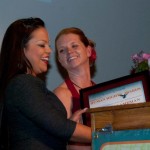
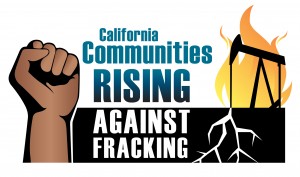



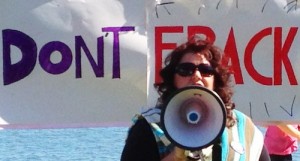
![photo[4]](https://globalexchange.org/wp-content/uploads/photo4-225x300-1.jpg)
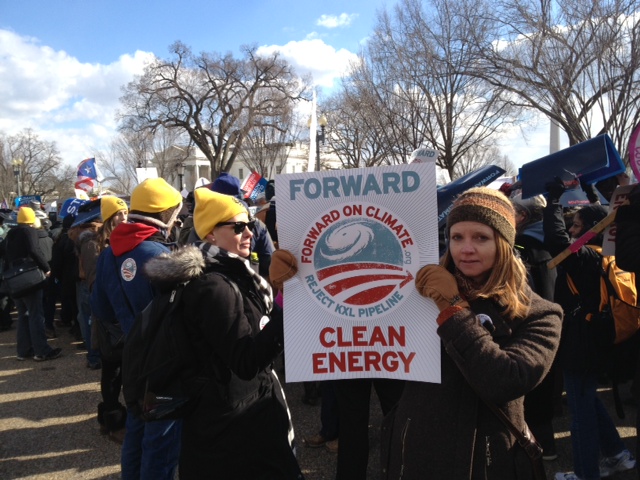

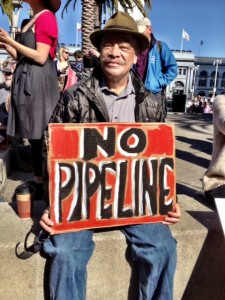
 TAKE ACTION
TAKE ACTION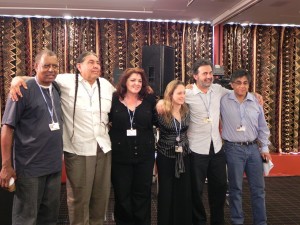
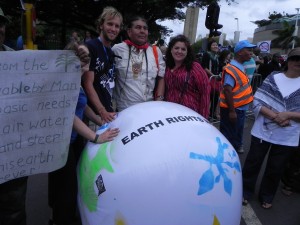

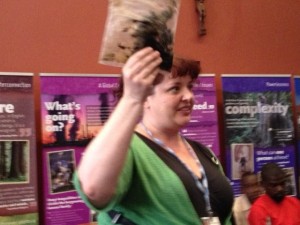
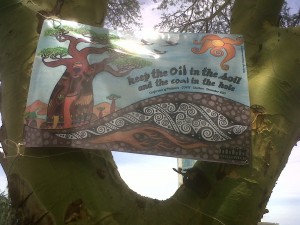

 Shannon Biggs is the Director of the Community Rights program at Global Exchange. She recently co-authored a book, Building the Green Economy: Success Stories from the Grass Roots (PoliPoint Press). Her current work focuses on assisting communities confronted by corporate harms to enact binding laws that place the rights of communities and nature above the claimed legal “rights” of corporations. Shannon@globalexchange.org
Shannon Biggs is the Director of the Community Rights program at Global Exchange. She recently co-authored a book, Building the Green Economy: Success Stories from the Grass Roots (PoliPoint Press). Her current work focuses on assisting communities confronted by corporate harms to enact binding laws that place the rights of communities and nature above the claimed legal “rights” of corporations. Shannon@globalexchange.org Osprey Orielle Lake is a lifelong advocate of environmental justice and societal transformation. She is the director of the Women’s Earth and Climate Caucus (WECC) and on the Board of Praxis Peace Institute. Her book, Uprisings for the Earth: Reconnecting Culture with Nature,(White Cloud Press) is a 2011 Nautilus Book Award winner. In 2010, she initiated Rights of Nature into the framework of WECC’s working groups and is a member of the Global Alliance for the Rights of Nature.
Osprey Orielle Lake is a lifelong advocate of environmental justice and societal transformation. She is the director of the Women’s Earth and Climate Caucus (WECC) and on the Board of Praxis Peace Institute. Her book, Uprisings for the Earth: Reconnecting Culture with Nature,(White Cloud Press) is a 2011 Nautilus Book Award winner. In 2010, she initiated Rights of Nature into the framework of WECC’s working groups and is a member of the Global Alliance for the Rights of Nature.